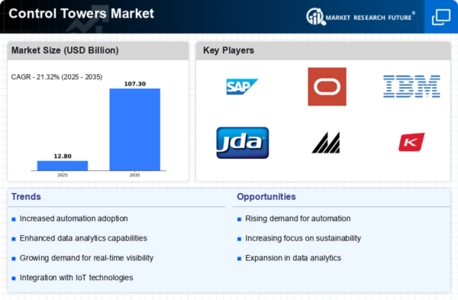Focus on Risk Management
The focus on risk management is becoming increasingly prominent within the Control Towers Market. Organizations are now prioritizing the identification and mitigation of risks associated with supply chain disruptions. This shift is evidenced by a growing investment in control tower solutions that offer comprehensive risk assessment tools. Recent statistics indicate that companies implementing these solutions have reduced their risk exposure by up to 40%. By utilizing advanced analytics and scenario planning, businesses can proactively address potential challenges, thereby safeguarding their operations. This trend underscores the necessity for robust risk management strategies in an ever-evolving market landscape, further solidifying the role of control towers as essential tools for resilience and sustainability.
Rising Demand for Real-Time Data
The rising demand for real-time data is a pivotal driver in the Control Towers Market. Organizations are increasingly recognizing the importance of having immediate access to supply chain information to make informed decisions. This trend is reflected in the market, where the demand for real-time visibility solutions has surged, with a reported increase of 30% in adoption rates over the past year. Companies are investing in technologies that provide instant insights into inventory levels, shipment statuses, and potential disruptions. This shift not only enhances operational efficiency but also improves customer satisfaction by ensuring timely deliveries. As businesses strive for agility and responsiveness, the Control Towers Market is evolving to meet these expectations, positioning itself as a critical component of modern supply chain management.
Adoption of Cloud-Based Solutions
The adoption of cloud-based solutions is reshaping the landscape of the Control Towers Market. Organizations are increasingly migrating to cloud platforms to enhance scalability, flexibility, and collaboration across their supply chains. Recent market analysis indicates that the cloud segment is expected to account for over 50% of the control tower solutions market by 2026. This transition allows companies to access real-time data and analytics from anywhere, facilitating better decision-making and responsiveness. Furthermore, cloud-based solutions often come with lower upfront costs and reduced IT overhead, making them attractive to businesses of all sizes. As the demand for agile and efficient supply chain management continues to rise, the Control Towers Market is likely to see accelerated growth in cloud adoption.
Increased Focus on Customer Experience
An increased focus on customer experience is driving innovation within the Control Towers Market. Companies are recognizing that enhancing customer satisfaction is paramount to maintaining competitive advantage. As a result, there is a growing emphasis on utilizing control tower solutions to streamline operations and improve service levels. Data suggests that organizations that prioritize customer experience through effective supply chain management see a 20% increase in customer retention rates. By leveraging control towers, businesses can gain insights into customer preferences and optimize their supply chain accordingly. This alignment not only fosters loyalty but also enhances brand reputation, making control towers indispensable in the quest for superior customer engagement.
Integration of Artificial Intelligence
The integration of artificial intelligence (AI) into the Control Towers Market is transforming operational efficiencies. AI technologies enable predictive analytics, which assists organizations in anticipating disruptions and optimizing supply chain processes. According to recent data, the AI segment within the control tower solutions is projected to grow at a compound annual growth rate of 25% over the next five years. This growth is driven by the increasing need for real-time decision-making capabilities and enhanced data analysis. Companies are leveraging AI to automate routine tasks, thereby allowing human resources to focus on strategic initiatives. As a result, the Control Towers Market is witnessing a shift towards more intelligent systems that can adapt to changing market conditions and consumer demands.



.webp)
.webp)
.webp)
.webp)
.webp)
.webp)








Leave a Comment